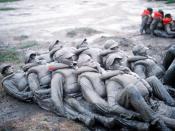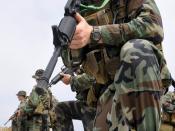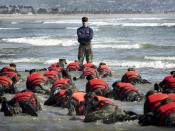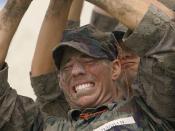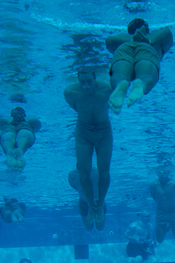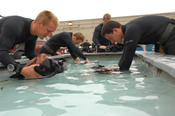SO YOU WANT TO BE A NAVY SEAL? From Sea, Air, and Land, the U.S. Navy Seal Teams are the most feared and respected commando forces in the U.S military if not the world. The Seal Teams are the most elite and highly trained forces on the face of the earth. President John F. Kennedy formed the teams in 1962 as a seagoing counterpart to the U.S Army Special Forces.
Most Seal missions are unreported and unknown to the general public. The Seals are trained to operate in small units, one or two men, or a platoon consisting of sixteen or more men. Not all Seal teams are made for everyone, in fact 80% of the men who attempt to become one, fail or will drop out. To become a Seal you must have dedication, hardwork, and a lot of commitment.
The process of becoming a seal is broken down into three different phases, Phase 1, Phase 2, and Phase 3.
"The first phase starts with a bang and ends with a boom," says Travis Schweizer, a twenty-three year-old Seal. Phase 1 consists of a two and three-mile timed run, physical training, one to two mile ocean swims, and a gut burning obstacle course. These items are a part of everyday delight for these men. Phase 1 lasts for approximately eight weeks and that is only if you do not get set back.
The First five weeks the student's learn life saving, knot tying, underwater knot tying, basic first aid, and surf passages in small inflatable boats. Along with this is a 50-yard underwater swim, which must be completed and the students are often revived when they pass out. Also throughout out the whole six months of BUD/S (Basic Underwater Demolition School), the Seal Teams go through many torturous events and lessons. One of these being surf torture. This is where the entire class must wade into the surf zone to their waistline, then sit down with arms linked. Just to let you know the water in Coronado, California never gets above sixty-eight degrees during the summer and fifty-eight degrees during the winter. There the men with linked arms will sit there for hours at a time, soon the cold sucks out all of their body warmth and the whole class is shivering in unison as the waves crash over there heads.
After this the men will find themselves doing hours of calisthenics to warm up, only to go back in the cold water for a few more hours. This is a very effective way to teach a potential Seal to mentally resist the effects of hypothermia, which could likely save your life in the future.
After the first four weeks of Phase 1, it leads into what is properly called "Hell Week". Hell week is the make or break test during first phase and a defining moment in the lives and careers of most Seals. This week consists of five days and five nights of not-stop training with a total of two total hours of sleep. The class is broken down into boat crews that must run everywhere with their IBS (Inflatable Boat-Small) on their heads.
During Hell Week the true enemy is the cold. Cold makes the weak quit and the determined seek strength through teamwork and helping their fellow students. At the beginning of Phase 1, there are usually about 100 students. By the end to Hell Week, there is only about twenty-five remaining. After the third day, many students start hallucinating due to a lack of sleep and fatigue. Once the week has ended, all of the remaining students are assigned to a doctor for a hygiene inspection. By the end of the week blisters have become ulcers. Neck and shoulder blades were rubbed raw from their vests. Limbs are swelled with cellulitis, which occurs when the skin becomes severely infected by cuts and gashes.
To survive the first week you must be determined, and have no limits at all. The true reason for Hell Week is to test ones mental strength, and teamwork ability. The final three weeks of the First Phase teaches the students the basics of what the old Underwater Demolition Teams did during WW II, the Korean War, and Vietnam War. Once these eight weeks are up many of the students are relieved, that is until they fin out they still have seventeen more weeks. But luckily they will never have to go through another Hell Week.
During Phase 2 the physical training becomes more intense as do the qualifying times for the timed runs and the swims and obstacle courses become more demanding. The only similarity between these two phases is the four-mile ocean swim and the twelve-mile timed run. The next big hurdle in Phase 2 is the "Pool Comp". In Pool Comp you will be in full dive gear with a double hose regulator on the dive tanks and swim along the deep end of the Combat Training Tank. Soon, as swift as a shark attack, you are tossed around lie a rag doll and will have all of your gear and tanks torn from your body. The underwater aggressor ties the regulator hoses in knots. You are in an unstable position and could easily panic and swim for the surface. However, if that occurs, you will fail the test and be set back for a week.
The second Phase is basically based on diving and life saving maneuvers underwater. Many times this phase sets back many students, which means they must go through these tactics over and over until they pass. During these 7 weeks you will learn about the underwater explosive device and how and where to attach it to a ship. You can expect to conduct close to fifty dives during this period of training. This course will teach you many things about submarines and how to escape them if necessary. It also teaches you a lot of surviving skills that are mandatory for an everyday life as a Seal. Once you have completed this Phase you move on to your final Phase, which is known as Phase 3.
Phase 3 is a Land Warfare Phase, which teaches students about guns and explosives that they will be working with. Students learn basic marksmanship with the primary Seal weapons, the M-16 and the pistol. Basic Patrolling and Immediate Action Drills are taught in both the classroom and the field. The students are taught how to use heavy weapons like the M-60 machine guns, M-79 and M203, 40-mm grenade launchers, hand grenades and Anti-Tank weapons. Basic Field demolitions finish up the commando training. The field explosives include drop off charges, the claymore mind, shape chargers, and improvised explosive booby traps.
Hand-to-hand combat training continue at a higher intensity level. Of course the PT (Physical Training) picks up in intensity as well. The trainees, whose bodies and minds are already hardened from four months of non-stop PT, are broken down once again to reach new limits. A 5.5 ocean swim and a fourteen-mile run mark the milestones of Phase 3. One of the more lighthearted training exercises is the "flights" up a steep hill carrying a wooden pallet. The students must follow proper flight procedures such as staying in the flight pattern and requesting permission to land.
The students then move on to Night Patrols. The Final Field Training is held over a five day-night period. Each squad enters isolation to begin the mission planning process and conducts four back to back night operations using most of the commando skills taught during the six month BUD/S training. The Third Phase concentrates on teaching land navigation, small-unit tactics, rappelling, military land and underwater explosives and weapons training. The final four weeks of Phase 3 are spent teaching students to apply techniques acquired throughout training in a practical environment.
Graduation day is probably the most anticipated event for all "tadpoles" (the name given to the students who are in SEAL training, but have not yet completed all 3 phases). The twenty or so men who graduate with stern faces and hardened bodies, show little resemblance to the wide eyed kids who arrived on the quarter-deck six and half months earlier to set sail on the journey of a lifetime. The moment of reflection and rest is short lived though. For now it is off to jump school, then assigned to a Seal team on the East or West Coast. Once on the Seal Team, it becomes clear that training has just begun. From now on they must prove worthy of wearing the coveted "Trident" Naval Warfare emblem. Once at Jump School these determined men will now start learning the proper techniques of jumping out of a perfectly good plane. This is known as Post BUD/s training. This is a thirty-week course that teaches you everything you need to know about war combat, and jumping techniques. Though grueling and tedious, the rewards for hard work and studying are priceless. You leave the military with a whole new meaning of life. To be able to protect your friends, family, and country is an honor that anyone should be able to enjoy.
